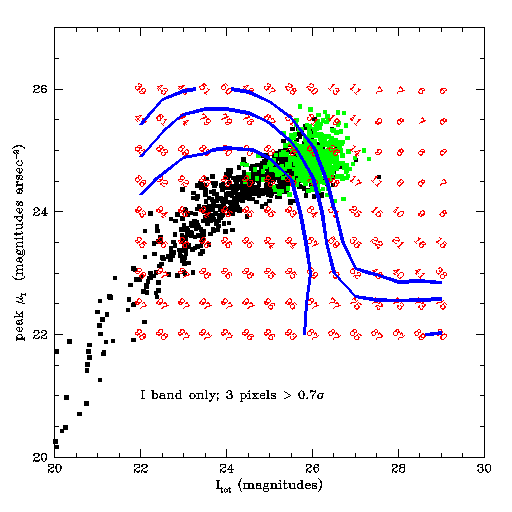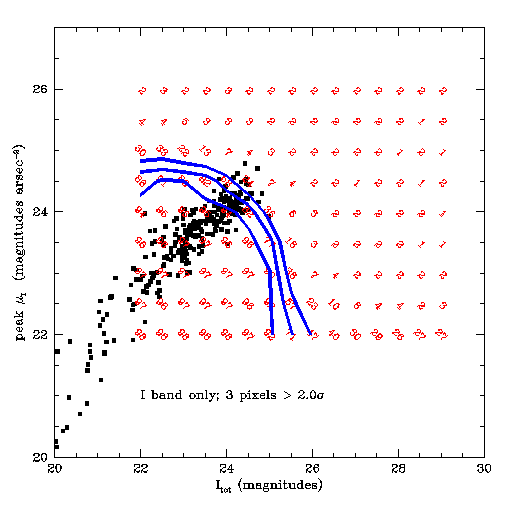
| The idea here is to test various galaxy detection methods to see which
produce the deepest, most reliable galaxy catalogs by adding artifical
galaxies to a subection of the VIRMOS images and attempting to
retreive them using various detection criteria. Both depth and reliability are important. In the extreme example, if uses as detection criteria: "an object must have greater than the sky background flux in one or more pixels" (an extremely liberal example) one will have an extremely deep catalog, but not a reliable one. If however one only uses: "galaxies which are detected in all four bands at the 20-sigma level", one will have a very reliable catalog, but one will not detect any Lyman break galaxies. There are two tests: one is to test the rate at which galaxies are missed; the second is to test the rate at which noise peaks are mistaken for genuine objects. To test the completeness limits of various detection schemes I have
written a program which adds several artifical galaxies to a 1024x1024
pixel sub-section of the VIRMOS images. One can then run SExtractor to
see which galaxies are detected. By varying the surface brightness and
magnitudes one can determine completeness as a function of these
The image subsection was provided by Henry McCracken. It is a portion of the 2 hr field. I have further reduced the image in size (to speed the iterations) to 1024x1024 subsection. The entire subsection is imaged to the same depth; that is to say, the weighting is uniform. This is obviously a much simplified version of what will be a much more complicated problem. The Fortran program (addgal4.f) adds
galaxies to the I-band image. Initially, the added galaxies are modeled
with an face-on exponential profile. (See version
1 of this page.) However since only a few galaxies will have such profiles,
more realistic galaxies are now added. Further, since the effects of seeing
are important, one must convolve the exponential profile with a Gaussian.
This will alter the surface brightness, making it hard to generate galaxies
with the correct surface brightness.
A set of 100 bright, isolated galaxies was selected out of the field and ssembled into a master list. Postage stamps of these galaxies were cut out of the field. In order to test the magnitude limits, the galaxies are made fainter. This done by dividing the postage stamp by some number to scale it down to a fainter total magnitude. Testing the surface brightness limits is trickier. To make a galaxy fainter while keeping its total magnitude constant, one must spread the galaxy out, extending its wings. This was done by resampling the original galaxy images at sub-pixel resolution, interpolating as necessary, using bi-linear interpolation. In this way it possible to take a bright galaxy and fade it out to any surface brightness and total magnitude. Each time addgal4 is run, it adds 40 galaxies. Adding more generally results in artifically low completeness especially at bright magnitudes, as the galaxies start to overlap with each other and with the real galaxies. As it is, the maximum possible completeness is about 98-99%. All the galaxies are of the same brightness (I and µI). The galaxies are selected at random from all the galaxies on the master list. Only galaxies brighter than the desired magnitude/surface brightness combination are used: brightening a faint galaxy is obviously undesirable. Each galaxy is then faded and smeared to the desired magnitude/surface brightness combination and added to the image. The program then writes the image and the location of the added galaxies to disk. Galaxies are added to all 4 of the BVRI images, although currently, only the I band is used for detection. The figure below illustrates this procedure. One can then run SExtractor to retrieve the artifical galaxies, with whichever detection criteria are desired. This process can be repeated several times for a range of magnitudes and surface brightnesses. The process needs to be run about 10 times at for (I, mu_I) pair. Currently, this process is controlled with PERL script: comp.pl To test the false-positive rate, The original image was multiplyed by -1; the noise peaks became noise troughs and vice-versa. SExtractor was run, using the same detection criteria. Since there are no real negative galaxies, all the objects thus detected are spurious. The galaxies are plotted up in the magnitude/surface brightness plane. The following graphs are plots of surface brightness in the I band vs. total I magnitude. The dots show detected galaxies. The red numbers give the completeness levels (in percent) at different values of magnitude and surface brightness as determined from the simulations. The blue lines are contours at the 90, 70 and 50 completeness limits. The green dots show the false-positive detections |
| The detection criteria for the graph to the right are: 3 contiguous pixels in the I band image must be greater than 0.7 times the RMS of the background. Note the large number of false detections. |  |
| The detection criteria for the graph to the right are: 3 contiguous pixels in the I band image must be greater than 2.0 times the RMS of the background. Not surprisingly, considerably fewer galaxies are detected. However, no false galaxies were detected in the negative image. |  |
| This is a substanstial improvement over the first version. The next step is to use the actual detection criteria, using the combined images. |